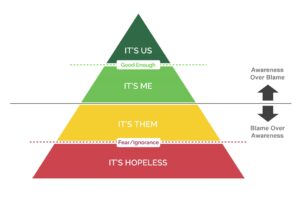By: Ashley Michael
Nobody creates company values with ill intention. Values are supposed to set the tone about how people should act, explain what the company stands for and in a best case scenario, enhance the organization’s reputation and trust among customers, partners and stakeholders.
But are your written values translating into how people act? Or are they just words on a wall, or worse, words in a document 4 levels deep in your Dropbox?
 Lately we’ve been sharing our observations on the differences we see in performance across the organizations we work with, and how companies can elevate themselves from one performance zone to the next. One of the key differentiators between organizations who are “below the line” and those that are “above the line” is the extent to which they are truly “being” who they want to be, as expressed by their corporate values. In fact, we have noticed a direct correlation between the extent to which an organization lives their values and their performance.
Lately we’ve been sharing our observations on the differences we see in performance across the organizations we work with, and how companies can elevate themselves from one performance zone to the next. One of the key differentiators between organizations who are “below the line” and those that are “above the line” is the extent to which they are truly “being” who they want to be, as expressed by their corporate values. In fact, we have noticed a direct correlation between the extent to which an organization lives their values and their performance.
The Organizational Hierarchy
In the lowest performing organizations who we consider to be in the “Red Zone,” an established set of corporate values either don’t exist at all or they aren’t widely known. At the next level, we see mediocre performance in the “Amber Zone,” where values are clearly articulated, but they don’t go beyond the poster on the wall… people are “saying it” and nothing more. Most high performing organizations are in what we call the “Light Green Zone,” where most people are taking actions and implementing initiatives aligned with the values. Here, people are “doing it”. However, in the highest performing organizations, in the “Dark Green Zone,” the values have become an integral part of the company’s culture and identity. They’re deeply ingrained into all practices, decisions, behaviours, and interactions that shape the conduct of all employees. People are “being it”.
Company Values in the Amber Zone
The Amber Zone is rife with potential. To paint the picture of this zone for you – from a leadership perspective, leaders are treading water trying to keep up and follow the changing plans. From a performance perspective, performance in some areas is good and in others not so good, averaging out to mediocre. And from a culture perspective, company values exist but aren’t well known, shared or integrated. Often what we see is that the intention of the value and reality of what’s happening can be quite different.
Here are some examples:
Value: Collaboration
Intention: Understanding others, collaborating effectively across functions, effective listening.
Reality: Siloed departments or teams, internal competition, lack of support for cross-functional initiatives.
Value: Customer Focus
Intention: Putting the customer first, delivering exceptional service, prioritizing customer satisfaction.
Reality: Internal policies or practices that prioritize profit over customer needs, lack of responsiveness to customer feedback.
Value: Innovation
Intention: Fostering creativity, forward thinking, curiosity, embracing and championing change, supporting new ideas.
Reality: Resistance to change, bureaucratic hurdles that stifle new initiative, a culture that penalizes failure rather than seeing it as a part of the innovation process.
Value: Inclusion
Intention: Embracing diversity, creating an inclusive environment, and promoting equality.
Reality: Lack of diversity in leadership positions, unconscious bias in hiring or promotion practices, and an environment where certain groups feel marginalized or unheard.
Integrate Your Values
Does this sound familiar? If so, you aren’t alone. This is common and one of the many things that differentiate the amber zone organizations from the light green is how they integrate their values.
So, you might be wondering what you can do. Here’s some suggestions.
- Make sure your values are clear and easily understood. Don’t worry, we aren’t suggesting re-writing them, but they might require a couple of tweaks. Could they be simplified or made snappier? People’s ability to remember long lists isn’t good.
- Integrate your company values into policies and practices. Do you value innovation but require multiple levels of approval to try something new? How can you match your practices with what you value?
- Define what the values look like in behaviour. Collaboration can mean many things to many people. What will you be hearing and seeing if people are collaborating effectively? Create a list of the behaviours you’ll be seeing for each of your values and share it. This creates a great foundation for accountability since clear behaviours are spelled out.
- Integrate your company values into rewards and recognition systems. How are you reinforcing the behaviours you want people to repeat? At the organization level, this could be a monthly nomination for someone living the values, and at the team level this could be starting team meetings with “kudos” for someone living the values. Find ways to thread values through recognition.
- Lead by example. How are YOU living the values? Do you know what they are? Do you talk about them? Ask yourself how you can take accountability to bring them to life.
And that’s the key of moving out of the Amber Zone into the Light Green Zone. A belief that better is possible, and a willingness to build awareness and take some accountability.
If you’re interested in learning more about what we do at The Roundtable, book a scoping call with a member of our team by reaching out to learn more. In the meantime, download our latest guide on group coaching.




